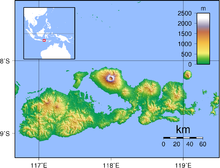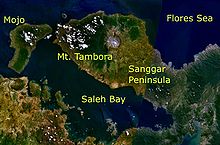Mount Tambora
![]()
The title of this article is ambiguous. For other meanings, see Tambora (disambiguation).
Tambora (also Temboro) is an active stratovolcano on the island of Sumbawa in Indonesia, east of Java. Sumbawa is fringed by oceanic crust to the north and south. Tambora was formed by active subduction zones beneath it. This process raised it to a height of 4300 m, making the volcano one of the highest peaks in the Indonesian archipelago. In this process, magma flowed out of a large chamber within the mountain, which refilled over the period of several centuries. The volcanic activity of this chamber reached a peak between 10 and 15 April 1815.
In 1815, Tambora erupted with an intensity of 7 on the Volcanic Explosivity Index, the largest eruption since the Taupo eruption in New Zealand some 26,500 to 22,500 years ago. Heavy rainfall from volcanic ash reached as far as Borneo, Sulawesi, Java and the Moluccas. The eruption killed at least 71,000 people on Sumbawa and Lombok, of whom 11,000 to 12,000 died directly from the eruption. The material ejected by the eruption caused global climate changes that earned 1816 the name "Year Without a Summer" because of its impact on North American and European weather. In parts of the Northern Hemisphere, crop failure and increased mortality among livestock resulted in the worst famine of the 19th century. The number of indirect victims worldwide cannot be quantified.

Tambora on the Sanggar Peninsula. Right above in the same scale the Vesuvius near Naples as size comparison
Geographical location
Tambora is located on Sumbawa, one of the Lesser Sunda Islands. It forms a segment of the Sunda Arc, a chain of volcanic islands that make up the southern part of the Indonesian archipelago. Tambora is located on a peninsula of Sumbawa called the Sanggar Peninsula. To the north of this peninsula is the Floressee, and to the south is Saleh Bay, 86 km long and 36 km wide. In the mouth of the bay is the small island of Mojo.
Archaeology
In addition to seismologists and volcanologists who monitor the mountain's activity, biologists and archaeologists also conduct scientific studies in the Tambora area. In 2004, a team of volcanologists led by Haraldur Sigurdsson discovered a village buried under pyroclastic deposits near the crater (caldera) by the 1815 eruption. Bones and artifacts were recovered at the excavation site. At this site - also referred to as the "Pompeii of the East" in the press at the time because of the similar demise of the village - archaeologists hoped to have found the palace of the Rajah of the Tambora "kingdom" destroyed by the eruption. So far, there have been no other finds under the thick layers of material ejected from the crater.
Tourism
Today, the area also serves as a tourist destination. The two nearest towns are Dompu and Bima. Around the mountain slope are three villages, Sanggar in the east, Doro Peti and Pesanggrahan in the northwest, and the small town of Calabai on the west coast.
The caldera is accessible via two different routes. The first starts in the village of Doro Mboha to the south-east of the mountain and leads along a paved road to an altitude of 1150 m above sea level through kashu plantations. The end of this route is the southern part of the caldera at 1950 m above sea level, which can be reached by a hiking trail. This place is usually used as a base camp for volcano watching, as the caldera can be reached from there in about an hour. The second route starts from the village of Pancasila on the northwest side of the mountain. A driveway continues for about 7 km through coffee plantations to Lerang Tambora, a settlement of coffee planters, from where a sometimes arduous trail continues initially through dense tropical rainforest.

Topography of Tambora and its surroundings

Satellite image of Tambora
Geological history
Formation
Tambora lies 340 kilometres north of the Sunda Trench and 180 to 190 kilometres above the upper margin of the north-dipping Benioff Zone. Sumbawa is fringed by oceanic crust to the north and south. The rate of convergence of the Indo-Australian, Eurasian and Pacific plates meeting here is about 7.8 centimetres per year. The age of Tambora is estimated to be at least 57,000 years.
Tambora measures about 60 kilometers at sea level. The current altitude is 2850 m compared to an estimated 4300 m before the eruption in 1815.
According to a geological survey, before the eruption Tambora had a high volcanic cone with a central shaft from which lava frequently escaped and flowed down the flanks of the mountain. Today, the stratovolcano consists of the volcanic deposits within the caldera, which reach up to its rim with heights of up to 2700 m in the northwest and up to 2750 m in the west and southwest.
The older stratovolcano consists of interlocking layers of lava and pyroclastics, the successor is formed to about 40% of one to four meters thick, often interrupted lava flows.
There are at least 20 subsidiary cones, some of which have been named: "Tahe" (877 meters), "Molo" (602 meters), "Kadiendinae", "Kuba" (1648 m) and "Doro Api Toi". Most of these secondary cones produced basalt lava flows.
Eruption history
Radiocarbon dating has shown that there were three eruptions of Tambora before 1815, but their magnitude is unknown. The dates are estimated to be 3710 BC (± 200 years), 3050 BC and 740 AD (± 150 years). All eruptions had comparable characteristics: an explosive eruption of the volcano from the central eruption channel, with the last one having no pyroclastic flows.
In 1812, Tambora became highly active, reaching its eruptive maximum in April 1815. The eruption was equivalent to a magnitude seven on the VEI scale, with a total of 60 to 160 cubic kilometers of ejected pyroclastic precipitation. Features of the eruption included explosive eruptions from the central channel, pyroclastic flows, tsunamis, and a caldera collapse. The eruption had long-term effects on global climate. Follow-up activity from the volcano was recorded in August 1819 in the form of a small eruption of magnitude two on the VEI scale. Between 1850 and 1910, eruptions occurred again, but were confined to the caldera. Small lava flows and domes were created. The strength was two on the VEI scale. During these eruptions, the "Doro Api Toi" - a secondary cone within the caldera - was created.
The last eruption of Tambora was recorded in 1967, and it was a very small, non-explosive eruption.
Questions and Answers
Q: What is Mount Tambora?
A: Mount Tambora is an active volcano located in Indonesia.
Q: Where is Mount Tambora located?
A: Mount Tambora is located at 8°14’41”S, 117°59’35”E in Indonesia.
Q: Why was Mount Tambora taller before its explosive volcanic eruption in 1815?
A: Mount Tambora was taller before its explosive volcanic eruption in 1815 because the eruption caused a collapse of its summit.
Q: How many people died because of Tambora's explosive volcanic eruption in 1815?
A: Tens of thousands of people around the world died because of Tambora's explosive volcanic eruption in 1815.
Q: Have there been any smaller eruptions of Mount Tambora after the 1815 eruption?
A: Yes, there have been smaller eruptions of Mount Tambora after the 1815 eruption.
Q: What type of plate boundary is Mount Tambora on?
A: Mount Tambora is on top of a subduction zone.
Q: Is Mount Tambora still active?
A: Yes, Mount Tambora is still an active volcano.
Search within the encyclopedia